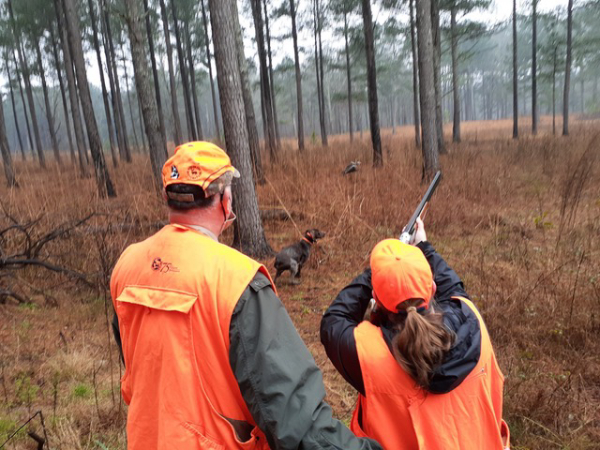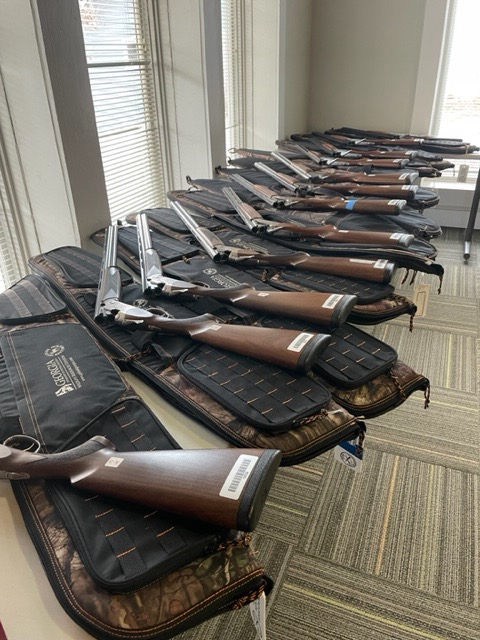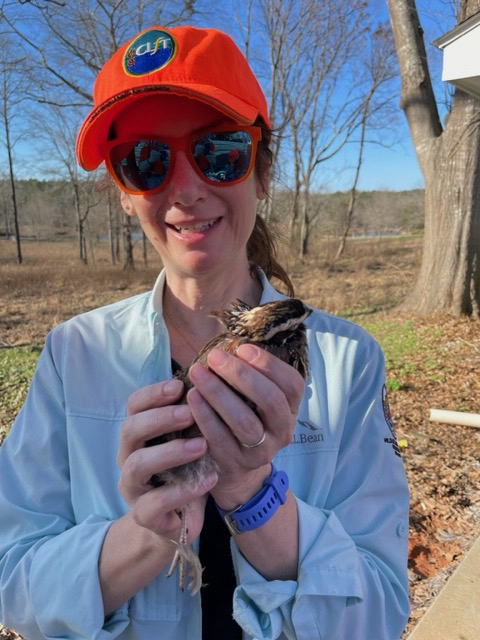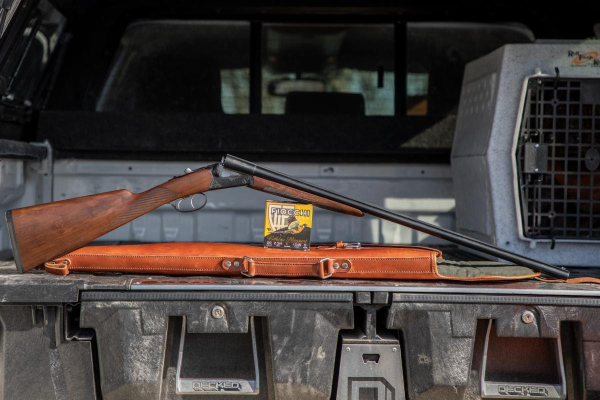Upland Hunting Deepens Connection to Conservation

By Tera Baird
A covey of bobwhite quail taking to the wing is an unforgettable sight. The sound, startling and chaotic. Add a German Shorthaired Pointer named Rhett locked up like a stone staring nervously into hummocks of switch grass, followed by the dull report of a Baretta O/U .20 gauge on my shoulder, and it all makes for a treasured experience. And a pivot point in one’s trajectory.
I am a wildlife biologist with the U.S. Fish and Wildlife Service in the Southeast. I have spent most of my career as a non-game biologist, and I was raised in a family that doesn’t hunt. So I’ve always felt a bit outside the realm of the hunting world. That changed when I had the opportunity develop further as a professional and participate in Conservation Leaders for Tomorrow (CLfT) at Charlie Elliot Wildlife Center in Mansfield, Georgia. The center is named after the renowned outdoor writer and the first director of Georgia Department of Natural Resources.

The workshop, sponsored by the Max McGraw Wildlife Foundation, is an intensive five-day hunting awareness and conservation education program designed for natural resource professionals who didn’t come into the profession through the portal of hunting. The workshop aims to give natural resource professionals a hunting immersion and encourages participants to explore and discuss the past and future roles of hunting in wildlife management. The goal isn’t to create new hunters but to foster a connection to a constituency we serve and provide that context for future natural resource leaders.
CLfT instructors are seasoned wildlife professionals, including retired game wardens, and current and retired state and federal wildlife agency biologists, as well as college professors. It was humbling and inspiring to be in the room with these leaders and learn what hunting means to them at both a personal and professional level. We learned about hunter safety (muzzle control!), eye dominance, zones of fire, and the different types of firearms. For many of us, including myself, this was the first time firing a gun or participating in a hunt. The workshop didn’t just focus on the “how-to-hunt”; we also explored topics like hunter motivations, ethics, and the future role of hunting in wildlife conservation.
We spent a day at the shooting range learning stance and how to mount a shotgun on a bird flush or launch of a clay target. It was initially awkward to lean forward while nesting the firearm in my shoulder and then bringing the stock against my cheek. I hit several clays but missed more than I hit.
After earning my hunter safety certificate and receiving my first-ever hunting license, I was ready for the trip to Buckeye Plantation in Covington, Georgia, for the quail hunt. We paired up with an instructor. I teamed up with Amber Barrow, a veteran wildlife biologist and educator with Georgia Department of Natural Resources—a seasoned hunter and falconer; I felt excited, prepared, and most importantly, well-trained and safe.
It impressed me how Rhett had a singular energetic focus—his nose in the air, nose to the ground—to find birds. And he did. Locked on-point, on command, he charged. Quail lifted nosily. I shouldered my firearm. Pointed. Fired. It was so exciting to hit the mark and I hooted and celebrated with Amber. The bird dropped quickly to the ground, and a puff of white feathers drifted slowly down to the earth. The dog handler said, “look at that Georgia snow!” Rhett retrieved the bird, and we identified it as male. I held it in my hand and said, “thank you,” but not to Amber. We were silent for a few moments looking at this beautiful bird, feeling a dual emotion of reverence and excitement. Our class materials quoted Edward Abbey: “Hunting is one of the hardest things even to think about. Such a storm of conflicting emotions!” How true. Death is life-affirming in the greatest paradox that’s been chewed on by thinkers dating to Antiquity.
Georgia Department of Natural Resources wildlife biologist Kevin Rose demonstrated wild game cooking in the workshop. We sampled orange duck, brined pheasant, jalapeño poppers with quail and cured duck. Hunting and then eating game, I felt a deeper connection to our food. Once at home, I served our quail in jalapeño, cream cheese and bacon with brown speckled bush beans from last summer’s garden.
I also brought home from Charlie Elliott a stronger sense of connection, gratitude, and a deeper understanding of the hunting community that I serve daily. I administer Pittman-Robertson funding used by state fish and wildlife agencies to restore and manage wildlife resources over a 10-state area.
Similar to the U.S. Fish and Wildlife Service’s Partner with a Payer initiative, this workshop is designed to broaden awareness, share experiences and foster conversations and understanding. The workshop was one of the most meaningful professional development programs I have attended and encourage other professionals to do the same.
—

Tera is with the U.S. Fish and Wildlife Service, Wildlife and Sport Fish Restoration, Southeast Region





